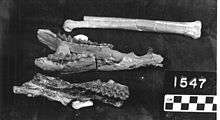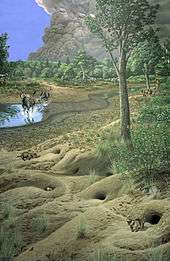Paratylopus
| Paratylopus Temporal range: Eocene–Oligocene | |
|---|---|
 | |
| Fossils | |
| Scientific classification | |
| Kingdom: | Animalia |
| Phylum: | Chordata |
| Clade: | Synapsida |
| Class: | Mammalia |
| Order: | Artiodactyla |
| Family: | Camelidae |
| Tribe: | Camelini |
| Genus: | †Paratylopus Matthew (1909) |
| Species | |
| |
Paratylopus is an extinct genus of terrestrial herbivore in the family Camelidae, endemic to North America from the Eocene through Oligocene 38.0—30.8, existing for approximately 7.2 million years.[1] It belongs to mammal class.
Taxonomy

Restoration of Paratylopus (upper right) and other animals from the late Oligocene of Oregon
Paratylopus was named by Matthew (1909) [named as subgenus by Matthew 1904; raised to genus level]. It was assigned to Camelidae by Matthew (1909) and Carroll (1988).[2][3]
Morphology
Four specimens were examined for estimated body mass by M. Mendoza, C. M. Janis, and P. Palmqvist. These specimens were estimated to weigh:
- 52.2 kg (120 lb)
- 44.8 kg (99 lb)
- 38.5 kg (85 lb)
- 42.9 kg (95 lb) [4]
Fossil distribution
Fossil distribution is centered in western Wyoming, eastern Nebraska to northeastern Colorado to southwestern South Dakota.
References
- ↑ PaleoBiology Database: Paratylopus, basic info
- ↑ W. D. Matthew. 1909. The Carnivora and Insectivora of the Bridger Basin, middle Eocene. Memoirs of the American Museum of Natural History 9:289-567
- ↑ R. L. Carroll. 1988. Vertebrate Paleontology and Evolution. W. H. Freeman and Company, New York 1-698
- ↑ M. Mendoza, C. M. Janis, and P. Palmqvist. 2006. Estimating the body mass of extinct ungulates: a study on the use of multiple regression. Journal of Zoology 270(1):90-101
This article is issued from Wikipedia - version of the 11/17/2016. The text is available under the Creative Commons Attribution/Share Alike but additional terms may apply for the media files.